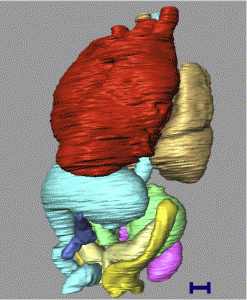金橋くんの修士論文がAnat Recに掲載されました。おめでとうございます。
肝臓の立体化、定量(廣瀬さん)、肝臓の形態異常個体のスクリーニング(田中さん)の研究、高解像度のMRI、位相CTの撮像と、多くの協力と成果のおかげで、論文にすることができました。
- 1156例(CS14-23)のMRI画像から、肝臓形成異常例をスクリーニング
- 高解像度の位相コントラストX線CT(PCT)で胚子内部の詳細な解析
- 極小肝臓グループの異常は、肝無形成(2例)、肝低形成(4)、および肝葉欠損(1)
- これらは、肝造血障害により子宮内胎児死亡につながる可能性
- 外部正常胚の子宮内集団における CS18 -21 の肝形成不全の有病率は、約 1.7%
18.Kanahashi T, Yamada S, Tanaka M, Hirose A, Uwabe C, Kose K, Yoneyama A, Takeda T, Takakuwa T, A novel strategy to reveal the latent abnormalities in human embryonic stages from a large embryo collection, Anatomical Record, 299,8-24,2016 10.1002/ar.23281(概要), *299(1),2016の表紙に採用されました。DOI: 10.1002/ar.23206 (cover page)
ABSTRACT
The cause of spontaneous abortion of normal conceptuses remains unknown in most cases. The study was aimed to reveal the latent abnormalities by using a large collection of embryo images from a magnetic resonance imaging (MRI) database and novel phase-contrast radiographic computed tomography (PXCT). MRI from 1,156 embryos between Carnegie stage (CS) 14 and CS23 from the Kyoto Collection were screened by using the volume of the liver as the target organ. Embryos with liver volumes ≥2 SD above or below the mean for the stage of development were screened and examined precisely on MRI. Embryos with potentially abnormal livers were further analyzed by using PXCT. Liver abnormality was detected in all 7 embryos in the extra-small liver group and in 2 of 8 embryos in the extra-large liver group. The abnormalities in the extra-small liver group consisted of hepatic agenesis (2 embryos), hepatic hypogenesis (4), and liver lobe defect (1). Among the 7 extra-small liver group, 2 had only liver abnormalities and 5 exhibited complications in other organs. Of the 2 embryos in the extra-large liver group, one had only a single liver abnormality and the other had a morphologically abnormal liver with complications in other organs. Most of such liver abnormality cases are not survive, as liver function becomes essential. The prevalence of liver malformations in CS18 and CS21 in the intrauterine population of externally normal embryos is approximately 1.7%. The present study is the first step toward the elucidation of the latent abnormalities resulting in spontaneous abortion in externally normal embryos. Anat Rec, 299:8–24, 2016.








